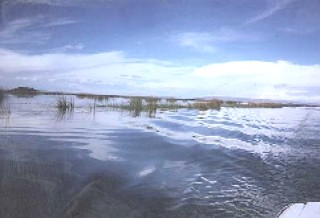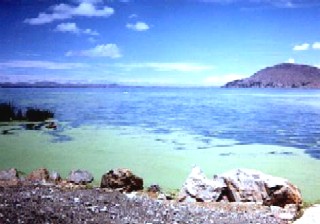LAKE TITICACA - EL LAGO TITICACA
The Titicaca Lake is between the territories of Peru and Bolivia, to a 3821 altitude of m.s.n.m., for this reason is considered the lake navigable more stop of the world.
It has an approximated surface of 8.560 kilometers square, with a wide length and approximated between 194 km and 65 km respectively, esteem that its Maxima llegaria depth to the 280 meters. The transparency of its waters is remarkable and reaches a temperature centigrade annual average of 13°.
In the flora of the lake it excels the totora. Its fauna this conformed by birds like: parihuanas, ducks, guallatas, zambullidores, chulumpi tiki and fish like trouts, pejerreyes, suches, etc.
In his waters they are up to 36 islands, being the most important floating islands of the Uros, Taquile, and Amantani.
El Lago Titicaca se encuentra entre los territorios del Perú y Bolivia, a una altitud de 3821 m.s.n.m., por este motivo es considerado el lago navegable más alto del mundo.
Tiene una superficie aproximada de 8,560 kilómetros cuadrados, con un largo y ancho aproximado entre los 194 km y 65 km respectivamente, se estima que su máxima profundidad llegaria a los 280 metros. La transparencia de sus aguas es notable y alcanza una temperatura promedio anual de 13° centígrados.
En la flora del lago sobresale la totora. Su fauna esta conformada por aves como: parihuanas, patos, guallatas, zambullidores, chulumpi tiki y peces como truchas, pejerreyes, suches, etc.
En sus aguas se encuentran hasta 36 islas, siendo las más importantes las islas flotantes de los Uros, Taquile, y Amantani.
 LAKE TITICACA
LAKE TITICACA
Photo: Cortesia de Gustavo Alva Ducato.
 LAKE TITICACA
LAKE TITICACA
Photo: Cortesia de Gustavo Alva Ducato.
THE DISEASE OF THE TITICACA. - LA ENFERMEDAD DEL TITICACA.
By Abraham Lama*
A green mantle in the navigable lake more stop of the world is bad symptom for the future of its blue waters, affected by urban water-drainages that make proliferate devastating seaweed, and by relaves miners with fatal consequences for the flora and fauna.
IT FILES. - To medium distance of the bay of the Peruvian city of Puno, the green emerald that covers waters with the Titicaca, the navigable lake more stop of the world, induces the tourists to use its cameras or filmadoras.
But that green idyllic one is deceptive, since in fact it is the symptom of one serious ecological disease.
He is not attractive either close by, because it smells bad. The green vegetable that floats on the lake shared by Bolivia and Peru has of three to four centimeters of thickness and is formed by an alga as large as a lentil, than it has propagated explosively.
The carpet of "lentejitas" absorbs the nutrients, prevents the passage of the solar light to the bottom of waters and it has not been allowing to the life of the fish and other animals, according to noticed for six years the Peruvian National University of the Plateau, the first organization that reacted before the problem.
The proliferation of the seaweed is fault of the man: they have been prospering for 12 years thanks to the nutrients contained in the liquid remainders that Puno spills in the lake.
The Titicaca lake is located to 3 thousand 810 meters of altitude above sea level and their waters are bombed by 12 collectors of water-drainage of Puno, the biggest city of the zone, with more than 130 thousand inhabitants.
Only 45 percents of the flows of water-drainage of the locality are lead to the plant of water treatment served as the Thorny spot. The rest unloading directly in the lake.
The problem worsens in the seasons of rain, when the sweepings of the city is dragged towards waters, due to the inadequate system of pluvial drainage.
The seaweed is not the only ecological problem in the Titicaca lake, because in other zones of this gigantic mass of water of 8 thousand 100 kilometers square the mining companies throw relaves (dreg and remainders) that kills the flora and the fauna.
Between August and October of 2000, a cruise of scientific research Peruvian-Bolivian, with the help of experts of other countries, measured in diverse points of the lake the environmental impact of relaves miners and the urban liquid remainders.
The report of Proyecto Especial Binacional Titicaca Lake (PELT) throws alarming results and confirms that the problem are agravated in the last four years.
The engineer Raul Marañón, person in charge of the investigating mission, briefed in his report that the biomass, that one decade ago was considered in 9 thousand 100 tons metric, is now of 49 thousand tons.
"Obvious, these numbers are global, but in the areas with presence of seaweed or in which miners throw relaves, the ictiológica fauna almost there is disappear, with serious effects for the population, that traditionally depended on its capture for its sustenance and feeding", Marañón commented.
"the problem is not only the diminution of the fishing potential, but the dangerous alteration of the balance of the ecosystem", added.
The report of the PELT conminó to the Peruvian government to complete the system of sewage system of Puno and to consider a project for the treatment to the totality of the served waters, that will be destined to the irrigation of the pastizales of the plateau, where "ichu" grows, one lasts and gramínea poor man.
Also, the authorities of Bolivia and Peru were committed to increase the control of the mining activities, to prevent that relaves is thrown to the lake.
* The author is IPS correspondent.
Un manto verde en el lago navegable más alto del mundo es mal síntoma para el futuro de sus azules aguas, afectadas por desagües urbanos que hacen proliferar algas devastadoras, y por relaves mineros con consecuencias fatales para la flora y fauna.
LIMA.- A mediana distancia de la bahía de la ciudad peruana de Puno, el verde esmeralda que cubre las aguas del Titicaca, el lago navegable más alto del mundo, induce a los turistas a utilizar sus cámaras fotográficas o filmadoras.
Pero ese verde idílico es engañoso, ya que en realidad es el síntoma de una grave enfermedad ecológica.
Tampoco es atractivo de cerca, pues huele mal. El verde vegetal que flota sobre el lago compartido por Bolivia y Perú tiene de tres a cuatro centímetros de espesor y está formado por un alga del tamaño de una lenteja, que se ha propagado explosivamente.
La alfombra de "lentejitas" absorbe los nutrientes, impide el paso de la luz solar al fondo de las aguas y no permite la vida de los peces y otros animales, según advirtió hace seis años la peruana Universidad Nacional del Altiplano, la primera entidad que reaccionó ante el problema.
La proliferación de las algas es culpa del hombre: prosperan desde hace 12 años gracias a los nutrientes contenidos en los desechos líquidos que Puno vierte en el lago.
El lago Titicaca está ubicado a 3 mil 810 metros de altura sobre el nivel del mar y sus aguas son bombardeadas por 12 colectores de desagüe de Puno, la ciudad más grande de la zona, con más de 130 mil habitantes.
Sólo 45 por ciento de los flujos de desagüe de la localidad son conducidos a la planta de tratamiento de aguas servidas de El Espinar. El resto se descarga directamente en el lago.
El problema se agrava en las temporadas de lluvia, cuando la basura de la ciudad es arrastrada hacia las aguas, debido al inadecuado sistema de drenaje pluvial.
Las algas no son el único problema ecológico en el lago Titicaca, pues en otras zonas de esta gigantesca masa de agua de 8 mil 100 kilómetros cuadrados las empresas mineras arrojan relaves (escoria y desechos) que matan la flora y la fauna.
Entre agosto y octubre de 2000, un crucero de investigación científica peruano-boliviana, con ayuda de expertos de otros países, midió en diversos puntos del lago el impacto ambiental de los relaves mineros y de los desechos líquidos urbanos.
El informe del Proyecto Especial Binacional Lago Titicaca (PELT) arroja resultados alarmantes y confirma que el problema se ha agravado en los últimos cuatro años.
El ingeniero Raúl Marañón, responsable de la misión investigadora, consignó en su informe que la biomasa, que hace una década se estimaba en 9 mil 100 toneladas métricas, es ahora de 49 mil toneladas.
"Obviamente, estas cifras son globales, pero en las áreas con presencia de algas o en que se arrojan relaves mineros, la fauna ictiológica casi ha desaparecido, con graves efectos para la población, que tradicionalmente dependió de su captura para su sustento y alimentación", comentó Marañón.
"El problema no es sólo la disminución del potencial pesquero, sino la peligrosa alteración del equilibrio del ecosistema", agregó.
El informe del PELT conminó al gobierno peruano a completar el sistema de alcantarillado de Puno y a considerar un proyecto para el tratamiento a la totalidad de las aguas servidas, que serán destinadas al riego de los pastizales del altiplano, donde crece el "ichu", una dura y pobre gramínea.
Así mismo, las autoridades de Bolivia y Perú se comprometieron a aumentar el control de las actividades mineras, para impedir que los relaves sean arrojados al lago.
* El autor es corresponsal de IPS.
Web site created on march 30 of 2005.
© Copyright 2005 Gualberto Valderrama C.
|